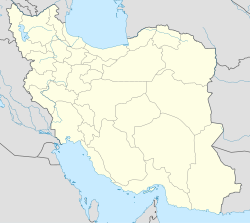Pasveh
Pasveh
Persian: پسوه | |
|---|---|
Village | |
| Coordinates: 36°47′52″N 45°19′44″E / 36.79778°N 45.32889°E[1] | |
| Country | Iran |
| Province | West Azerbaijan |
| County | Piranshahr |
| District | Lajan |
| Rural District | Lahijan-e Sharqi |
| Population (2016)[2] | |
• Total | 3,495 |
| Time zone | UTC+3:30 (IRST) |
Pasveh (Persian: پسوه)[a] is a village in, and the capital of, Lahijan-e Sharqi Rural District of Lajan District of Piranshahr County, West Azerbaijan province, Iran.[4]
Parsua civilization
[edit]Pasveh has a strategic location controlling the "easy" pass between the Lahijan district, in the Lesser Zab headwaters, and the Lake Urmia basin.[5]: 79
According to Vladimir Minorsky, Pasveh represents the name and location of the ancient Parsua kingdom.[5]: 79 He explained the difference in name by saying that r-deletion in consonant clusters is well-attested.[5]: 79 Pasveh was a frontier outpost near the Parsua's southern border (their core territory was probably the fertile Solduz district further north).[5]: 79
In the early 1200s, Yaqut al-Hamawi visited Pasveh and left a description in his works.[5]: 79 A century later, Hamdallah Mustawfi included an entry for it (here spelled Basavā or Pasavā) in his Nuzhat al-Qulub.[6] He described it as a small town in the tuman of Maragheh whose surrounding agricultural district produced grain, grapes, and some other fruits; he said its tax value was assessed at 25,000 dinars.[6] Pasveh later features in the accounts of Kurdish tribal feuds in the Sharafnama.[5]: 79 Much later, when Minorsky visited Pasveh in 1911, he described it as a "desolate" town with a "dilapidated" fort.[5]: 79
Demographics
[edit]Population
[edit]At the time of the 2006 National Census, the village's population was 2,977 in 515 households.[7] The following census in 2011 counted 3,777 people in 795 households.[8] The 2016 census measured the population of the village as 3,495 people in 869 households. It was the most populous village in its rural district.[2]
See also
[edit]Notes
[edit]References
[edit]- ^ OpenStreetMap contributors (27 September 2024). "Pasveh, Piranshahr County" (Map). OpenStreetMap (in Persian). Retrieved 27 September 2024.
- ^ a b Census of the Islamic Republic of Iran, 1395 (2016): West Azerbaijan Province. amar.org.ir (Report) (in Persian). The Statistical Center of Iran. Archived from the original (Excel) on 30 August 2022. Retrieved 19 December 2022.
- ^ Pasveh can be found at GEOnet Names Server, at this link, by opening the Advanced Search box, entering "-3078050" in the "Unique Feature Id" form, and clicking on "Search Database".
- ^ Mousavi, Mirhossein (c. 2023) [Approved 9 April 1366]. Creation and formation of four rural districts including villages, farms and places in Piranshahr County under West Azerbaijan province. lamtakam.com (Report) (in Persian). Ministry of the Interior, Council of Ministers. Proposal 6207.1.5.53. Archived from the original on 22 December 2023. Retrieved 22 December 2023 – via Lam ta Kam.
- ^ a b c d e f g Minorsky, Vladimir (1957). "Mongol Place-Names in Mukri Kurdistan". Bulletin of the School of Oriental and African Studies, University of London. 19 (1): 58–81. Retrieved 16 October 2022.
- ^ a b Hamdallah Mustawfi (1919). Le Strange, Guy (ed.). The Geographical Part of the Nuzhat-al-Qulub. p. 88. Retrieved 10 October 2022.
- ^ Census of the Islamic Republic of Iran, 1385 (2006): West Azerbaijan Province. amar.org.ir (Report) (in Persian). The Statistical Center of Iran. Archived from the original (Excel) on 20 September 2011. Retrieved 25 September 2022.
- ^ Census of the Islamic Republic of Iran, 1390 (2011): West Azerbaijan Province. irandataportal.syr.edu (Report) (in Persian). The Statistical Center of Iran. Archived from the original (Excel) on 20 January 2023. Retrieved 19 December 2022 – via Iran Data Portal, Syracuse University.


